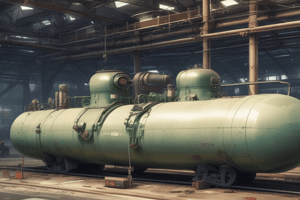Podcast
Questions and Answers
What distinguishes Low Pressure Plasmas (LPPs) from high-pressure plasmas?
What distinguishes Low Pressure Plasmas (LPPs) from high-pressure plasmas?
- Higher electron densities and lower plasma frequencies
- Higher electron densities
- Lower electron densities and higher plasma frequencies (correct)
- Lower plasma frequencies
Which field extensively utilizes Low Pressure Plasmas (LPPs) for surface modification and material functionalization?
Which field extensively utilizes Low Pressure Plasmas (LPPs) for surface modification and material functionalization?
- Material Science (correct)
- Agriculture
- Chemistry
- Medicine
What is one major application of Low Pressure Plasmas (LPPs) in the field of displays?
What is one major application of Low Pressure Plasmas (LPPs) in the field of displays?
- Increasing screen brightness
- Improving touch sensitivity
- Creating images in plasma TVs (correct)
- Enhancing audio quality
Why are Low Pressure Plasmas (LPPs) suitable for plasma-enhanced chemical vapor deposition (PECVD)?
Why are Low Pressure Plasmas (LPPs) suitable for plasma-enhanced chemical vapor deposition (PECVD)?
In what way do Low Pressure Plasmas (LPPs) contribute to improving industrial gases?
In what way do Low Pressure Plasmas (LPPs) contribute to improving industrial gases?
What aspect makes Low Pressure Plasmas (LPPs) superior for energy efficiency in modern display technologies?
What aspect makes Low Pressure Plasmas (LPPs) superior for energy efficiency in modern display technologies?
What is one major challenge faced by researchers working with LPPs?
What is one major challenge faced by researchers working with LPPs?
Why is scaling up LPP systems from laboratory experiments to real-world applications a challenge?
Why is scaling up LPP systems from laboratory experiments to real-world applications a challenge?
What are researchers focusing on to advance LPP research?
What are researchers focusing on to advance LPP research?
Why is modeling interactions between electrons, ions, and neutral particles in LPPs computationally intensive?
Why is modeling interactions between electrons, ions, and neutral particles in LPPs computationally intensive?
What is one future direction in LPP research mentioned in the text?
What is one future direction in LPP research mentioned in the text?
Why is there increasing interest in exploring new applications for LPPs?
Why is there increasing interest in exploring new applications for LPPs?
Study Notes
Low Pressure Plasmas (LPP)
Low pressure plasmas (LPP) are ionized gases generated under reduced pressure, typically below atmospheric pressure. They play a crucial role in many scientific and technological applications due to their unique properties and behavior. Here, we delve into the fascinating world of LPPs, exploring their characteristics, applications, and current challenges faced by researchers in this field.
Characteristics of LPPs
LPPs exhibit distinct features compared to other types of plasmas. For instance, they have lower electron densities (n_e) and higher plasma frequencies than high-pressure plasmas. These properties make LPPs suitable for a wide range of applications, such as plasma-enhanced chemical vapor deposition (PECVD), plasma etching, and plasma display panels.
Applications of LPPs
LPPs have found extensive use in various fields. In material science, they are employed for surface modification, doping, and functionalization of materials by forming thin films or creating nano-structures. They are also used to treat industrial gases to eliminate impurities and improve their quality.
Moreover, LPPs play a significant role in modern displays like plasma TVs, where they create images by ionizing the gas within the screen's pixels. This technology provides superior image quality and energy efficiency compared to other types of televisions.
Challenges in LPP Research
Researchers working with LPPs face several challenges that require innovative solutions to advance the field. One major challenge is the development of computational methods to accurately predict the behavior of LPPs under different conditions. This involves modeling complex interactions between electrons, ions, and neutral particles at low pressures, which can be computationally intensive.
Another challenge lies in scaling up LPP systems from laboratory experiments to real-world applications. This requires careful control of plasma parameters, such as temperature, density, and electric fields, to ensure consistent performance across varying scales.
Future Directions in LPP Research
To address these challenges and further explore the potential of LPPs, researchers are focusing on advancing simulation techniques and developing more powerful computing platforms. Open-source codes are being developed to facilitate multiscale and multiphysics simulations, allowing scientists to study LPPs over a wider range of length and time scales.
Additionally, there is increasing interest in exploring new applications for LPPs in areas such as biomedicine, environmental remediation, and space technologies. By expanding our understanding of LPP physics, we can unlock novel capabilities and harness the power of these unique plasmas for numerous scientific and technological breakthroughs.
Studying That Suits You
Use AI to generate personalized quizzes and flashcards to suit your learning preferences.
Description
Explore the characteristics, applications, and challenges associated with Low Pressure Plasmas (LPP), ionized gases generated under reduced pressure. Learn about their unique properties, uses in material science, and role in technologies like plasma TVs. Discover the research challenges and future directions in the field of LPPs.




